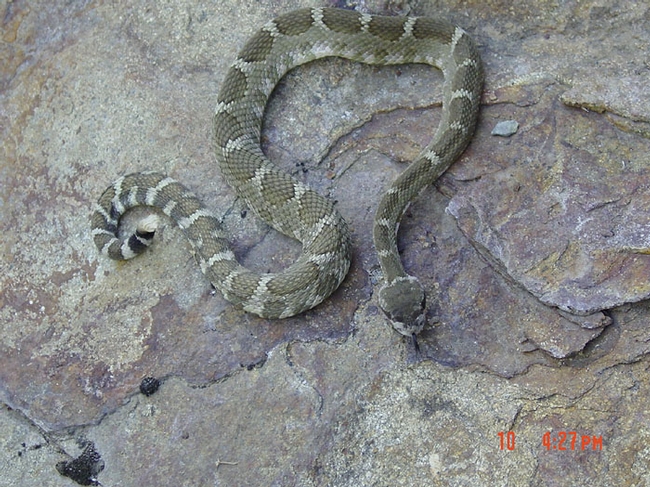By Marian Stevens, Butte County Master Gardener, July 11, 2014

Rattlesnakes can best be identified by their distinctive triangular head shape. Their rattles are less reliable features for identification because they are often broken off on older snakes. Young rattlesnakes are born with a small rattle or “button.” A new segment is formed each time the snake sheds its skin; since this may occur several times a year, the size of a snake's rattle is an unreliable indicator of age.
Most rattlesnakes forage near brushy or tall grass areas, rock outcrops, rodent burrows, around or under surface objects and sometimes in the open. Adults eat live prey, primarily rodents; young rattlers mostly consume lizards and young rodents. Rattlesnakes wait until their prey is nearby, then strike with two large fangs that inject venom. This subdues the prey, which is then swallowed whole.
Rattlesnakes are called pit vipers because they have small pits on either side of the head between the eye and the nostril. Sensitive to temperature, these pits assist the snake in finding prey. The snake's tongue and nostrils also detect the odors of prey. The venom is produced in glands behind the eyes, and then flows through ducts to the hollow fangs. Normally, the fangs fold back against the roof of the mouth, but when the snake strikes, the fangs are pivoted forward to inject the venom. A dead snake can still inject venom by reflex action for an hour or more after its death.
Rattlesnakes will usually avoid humans, but if a snake is disturbed or senses a threat, it will strike. While seldom fatal, bites are extremely painful and can lead to severe medical trauma. If you are bitten by a rattler, go to the nearest emergency facility for treatment. A veterinarian should immediately attend to dogs or domestic animals that have been bitten by a rattlesnake.
Be alert during the time of year when rattlesnakes are active: that is from April to October in our region. Rattlers hibernate and hide in rock accumulations and areas where they are protected. Unlike other reptiles, rattlesnakes give birth to live young. To protect their young, rattlesnakes will often give birth in abandoned rodent burrows.
Even though they are dangerous, rattlesnakes are important members of our ecosystem. They add to the diversity of California's wildlife. Remember to be careful when working in your garden or when moving brush or debris in your yard. Always hike with a friend in areas where rattlesnakes may be present. And never, ever, tease a snake.
For more information see: http://www.ipm.ucdavis.edu/PMG/PESTNOTES/pn74119.html
